ASRock DeskMini H470 Review: A No-Frills LGA 1200 mini-PC Platform
by Ganesh T S on December 29, 2020 8:00 AM ESTSPECworkstation 3 Benchmark
The DeskMini H470 can be equipped with powerful enough processors to make it suitable for specific workstation workloads. Obviously, the inability to add a discrete GPU to the machine hinders it in some cases. We still opted to run some of the tests in the SPECworkstation 3 benchmark program to evaluate the system for these types of use-cases.
The SPECworkstation 3 benchmark measures workstation performance based on a number of professional applications. It includes more than 140 tests based on 30 different workloads that exercise the CPU, graphics, I/O and memory hierarchy. These workloads fall into different categories.
- Media and Entertainment (3D animation, rendering)
- Product Development (CAD/CAM/CAE)
- Life Sciences (medical, molecular)
- Financial Services
- Energy (oil and gas)
- General Operations
- GPU Compute
Individual scores are generated for each test and a composite score for each category is calculated based on a reference machine (HP Z240 tower workstation using an Intel E3-1240 v5 CPU, an AMD Radeon Pro WX3100 GPU, 16GB of DDR4-2133, and a SanDisk 512GB SSD). The SPEC Ratio for the tests in each category is presented in the graphs below.
Media and Entertainment
The Media and Entertainment category comprises of workloads from five distinct applications:
- The Blender workload measures system performance for content creation using the open-source Blender application. Tests include rendering of scenes of varying complexity using the OpenGL and ray-tracing renderers.
- The Handbrake workload uses the open-source Handbrake application to transcode a 4K H.264 file into a H.265 file at 4K and 2K resolutions using the CPU capabilities alone.
- The LuxRender workload benchmarks the LuxCore physically based renderer using LuxMark.
- The Maya workload uses the SPECviewperf 13 maya-05 viewset to replay traces generated using the Autodesk Maya 2017 application for 3D animation.
- The 3ds Max workload uses the SPECviewperf 13 3dsmax-06 viewset to replay traces generated by Autodesk's 3ds Max 2016 using the default Nitrous DX11 driver. The workload represents system usage for 3D modeling tasks.
| SPECworkstation 3.0.4 - Media and Entertainment Workloads | |||
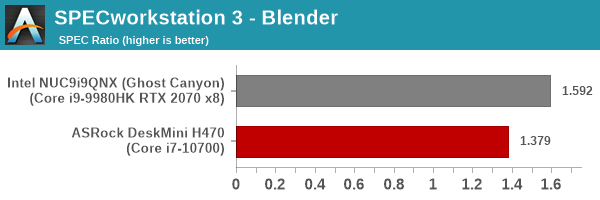
In Handbrake (which is reliant on the CPU capabilities only), the Ghost Canyon NUC and the DeskMini H470 are neck-to-neck. In all other benchmark components, the OpenCL capabilities of the GPU come into the picture, and the dGPU-less DeskMini is not able to get a favorable score.
Product Development
The Product Development category comprises of eight distinct workloads:
- The Rodinia (CFD) workload benchmarks a computational fluid dynamics (CFD) algorithm.
- The WPCcfd workload benchmarks another CFD algorithm involving combustion and turbulence modeling.
- The CalculiX workload uses the Calculix finite-element analysis program to model a jet engine turbine's internal temperature.
- The Catia workload uses the catia-05 viewset from SPECviewperf 13 to replay traces generated by Dassault Systemes' CATIA V6 R2012 3D CAD application.
- The Creo workload uses the creo-02 viewset from SPECviewperf 13 to replay traces generated by PTC's Creo, a 3D CAD application.
- The NX workload uses the snx-03 viewset from SPECviewperf 13 to replay traces generated by the Siemens PLM NX 8.0 CAD/CAM/CAE application.
- The Solidworks workload uses the sw-04 viewset from SPECviewperf 13 to replay traces generated by Dassault Systemes' SolidWorks 2013 SP1 CAD/CAE application.
- The Showcase workload uses the showcase-02 viewset from SPECviewperf 13 to replay traces from Autodesk’s Showcase 2013 3D visualization and presentation application
| SPECworkstation 3.0.4 - Product Development Workloads | |||
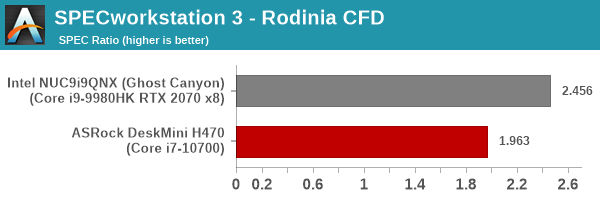
Workloads such as Rodinia, WPCcfd, and CalculiX are reliant mostly on CPU performance, and the DeskMini H470 and Ghost Canyon NUC are close in performance to each other. Other workloads that belong to SPECviewperf 13 are obviously GPU-focused, and here the dGPU-equipped Ghost Canyon NUC performs much better.
Life Sciences
The Life Sciences category comprises of four distinct test sets:
- The LAMMPS set comprises of five tests simulating different molecular properties using the LAMMPS molecular dynamics simulator.
- The NAMD set comprises of three tests simulating different molecular interactions.
- The Rodinia (Life Sciences) set comprises of four tests - the Heartwall medical imaging algorithm, the Lavamd algorithm for calculation of particle potential and relocation in a 3D space due to mutual forces, the Hotspot algorithm to estimate processor temperature with thermal simulations, and the SRAD anisotropic diffusion algorithm for denoising.
- The Medical workload uses the medical-02 viewset from SPECviewperf 13 to determine system performance for the Tuvok rendering core in the ImageVis3D volume visualization program.
| SPECworkstation 3.0.4 - Life Sciences Workloads | |||
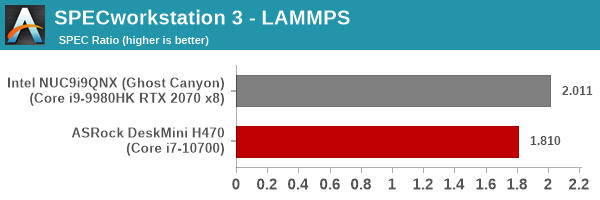
Other than the Medican workload that utilizes the GPU, the other scores are quite similar for both the Ghost Canyon NUC and the DeskMini H470.
Financial Services
The Financial Services workload set benchmarks the system for three popular algorithms used in the financial services industry - the Monte Carlo probability simulation for risk assessment and forecast modeling, the Black-Scholes pricing model, and the Binomial Options pricing model.
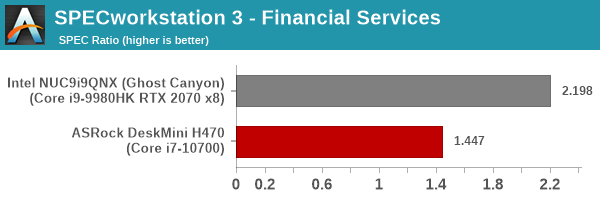
In these workloads, it is likely that the higher single-core turbo-boost for the Ghost Canyon NUC's Core i9-9980HK gives it an advantage over the Core i7-10700 in the DeskMini H470.
Energy
The Energy category comprises of workloads simulating various algorithms used in the oil and gas industry:
- The FFTW workload computes discrete Fourier transforms of large matrices.
- The Convolution workload computes the convolution of a random 100x100 filter on a 400 megapixel image.
- The SRMP workload processes the Surface-Related Multiples Prediction algorithm used in seismic data processing.
- The Kirchhoff Migration workload processes an algorithm to calculate the back propogation of a seismic wavefield.
- The Poisson workload takes advantage of the OpenMP multi-processing framework to solve the Poisson's equation.
- The Energy workload uses the energy-02 viewset from SPECviewperf 13 to determine system performance for the open-source OPendTec seismic visualization application.
| SPECworkstation 3.0.4 - Energy Industry Workloads | |||
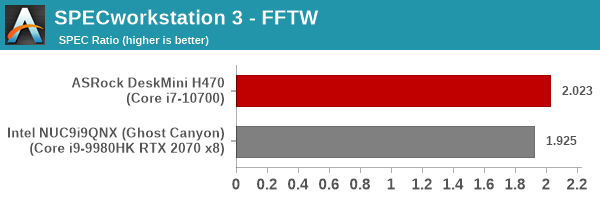
The GPU-focused Energy workload using the energy-02 SPECviewperf 13 viewset is a massive win for the Ghost Canyon NUC, but the other workloads see the DeskMini H470 compare quite favorably against it.
General Operations
In the General Options category, the focus is on workloads from widely used applications in the workstation market:
- The 7zip workload represents compression and decompression operations using the open-source 7zip file archiver program.
- The Python workload benchmarks math operations using the numpy and scipy libraries along with other Python features.
- The Octave workload performs math operations using the Octave programming language used in scientific computing.
- The Storage workload evaluates the performance of the underlying storage device using transaction traces from multiple workstation applications.
| SPECworkstation 3.0.4 - General Operations | |||

For general operations, the two 8C/16T systems perform very similar to each other. In the storage segment, the Ghost Canyon NUC equipped with a pure Optane primary drive performs almost 4x better than the DeskMini H470 configuration equipped with normal 3D TLC NAND.
We do not present any numbers in the GPU Compute category as the iGPU in the Intel Core i7-10700 is too unreliable to complete the component workloads (Caffe and Folding@Home) in a consistently reliable manner.










26 Comments
View All Comments
ingwe - Tuesday, December 29, 2020 - link
What a great value! I am impressed.JfromImaginstuff - Tuesday, December 29, 2020 - link
Seems pretty darn goodAdditionalPylons - Tuesday, December 29, 2020 - link
I agree that this is great value. Shame about not including 2.5 GbE though. Ganesh, are you planning to review the AMD counterpart Deskmini X300 as well? (Despite being a bit older it still supports the latest Renoir APUs.) Personally I'm hoping for something like this based on Cezanne APUs to be launched at CES. It is great having socketed CPU in the Deskmini, but I'd also gladly buy a Cezanne-based successor to e.g. Asus PN50, Gigabyte Brix or ASRockInd 4x4box.powerarmour - Tuesday, December 29, 2020 - link
Yep, not surprised it's the 'Intel' variant here...lmcd - Tuesday, December 29, 2020 - link
As a 2400G user, it makes sense why they didn't review it. It's dated.And Ian is the one that has the OEM-only APUs.
ganeshts - Tuesday, December 29, 2020 - link
I have a DeskMini X300 sample that arrived just a few days back along with a Renoir APU. Review should be out sometime in January.AdditionalPylons - Tuesday, December 29, 2020 - link
Great! Looking forward to that! And thanks a lot for this review as well!osteopathic1 - Tuesday, December 29, 2020 - link
How would this compare to a new Mac Mini with M1?At the same price point the mac has less ram/storage but does have an arguably more powerful processor and HDMI 2.0 for 4K at 60Hz.
The internal storage is likely not a factor anyway as most who use this as a HTPC will have external storage of some sort with their media on it.
Any thoughts?
fishingbait15 - Thursday, December 31, 2020 - link
Huh? With the exception of single core performance, the M1 chip isn't "arguably more powerful" than any hexacore or octacore Intel desktop chip. Most media and "tech" sites only compare the M1 to the dual and quad core "mobile" (more accurately laptop) chips that Apple replaced in the MacBook Air and entry level Mac Mini and MacBook Pros. The hexacore and octacore desktop chips are clearly more powerful, and it was that CPU that was used here. And with 16 GB of RAM instead of 8 GB that is in the $699 Mac Mini, the comparison favors this device even more.Further, I do not know if you missed it but this configuration has a pair of 4K displayports at 60Hz as well as a third 4K output at 30Hz and a 4th lower resolution output.
Most people will use this as a HTPC? Speak for yourself. It would work just fine for general purpose computing, and you can get an entry level graphics card to make it suitable for 1080p gaming for under $100. (Meanwhile the ARM CPU will make macOS even worse for gaming than before). The M1 Mac is a great accomplishment, and as a result we will see more ARM-based Windows, ChromeOS and Linux laptops starting maybe in late 2021 when hopefully SOMEONE will come out with a design that includes at least 2 Cortex X1 cores, or failing that more than 4 Cortex A78 cores. But devices like this are precisely why Wintel will continue to have a clear majority of the market.
wpcoe - Tuesday, December 29, 2020 - link
It looks like the motherboard tray is a solid piece of metal closely beneath the M.2 slot. How is the heat dissipation for an M.2 SSD?